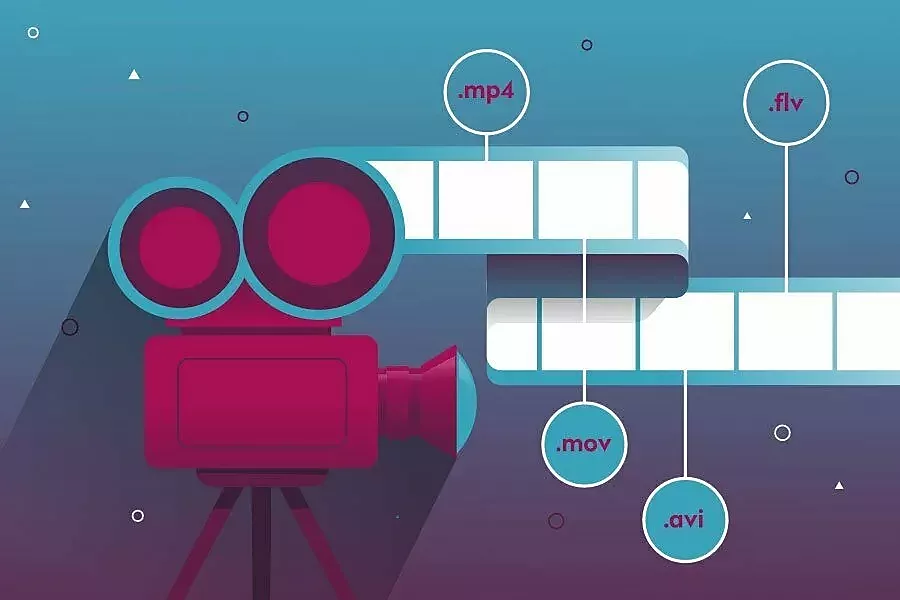You know explainer videos, image films, recruiting films, and many other forms of video implementation. But do you know all the details about the video formats and their special features? Read the most important information about the most relevant video formats.
No desire to read? Listen to the blogcast here:
In this article you will learn...
- All important information on the most common video formats, their special features, and their applications.
Jump directly to one of the following video formats:
MPEG-1
MPEG-2
MPEG-4
QuickTime
AVI
WMV / ASF
MKV
HTML5 / WebM
FLV / 3gp
When watching an image film or an explainer video, the video format utilized is rarely considered. However, the format becomes pertinent when it comes to marketing, placement, or embedding the video in various channels.
Therefore, familiarize yourself with the nine most important video formats in our article and quickly become a video format expert.
Container & Codec.
Before we delve into the individual video formats, two basic terms must first be defined:
- Container.
- Codec.
Video formats are “file containers” that contain various contents. In addition to audio and video files, a container can also contain menu structures or subtitles. When the film is played, the elements in the container are decoded.
Codecs are used to compress the files within a container, which affects the quality and size of the file. If a video is played, the files in the container are decompressed again using the appropriate codec.
Knowledge of the respective functions of containers and codecs is crucial for understanding the following nine video formats.
MPEG-1 (.mpg / .mpeg).
MPEG stands for Motion Picture Expert Group, an expert group that has dealt with video compression since the 1980s. MPEG is container and codec at the same time. MPEG-1 is the video CD standard and therefore no longer up to date. The high storage requirements and the fact that HD (High Definition) is not supported mean that MPEG-1 is no longer able to compete with newer video formats.
- Advantages: Wide distribution, compatible with most devices.
- Disadvantages: Outdated, poor video quality (not suitable for HD).
MPEG-2 (.mpg / .mpeg / .vob/ .m2p / .ts).
MPEG-2 is the further development of MPEG-1 and is the basis for DVDs. The codec of the MPEG-2 format is called H.262. The file extension on DVDs is .vob, while the MPEG format for camera recordings is usually a .ts file.
MPEG-4 (.mp4).
The MPEG-2 successor is the MPEG-4 format. Mp4 files are designed for high HD picture quality with low storage capacity. The most common codec is the standard H.264. In rare cases, the codecs DivX and Xvid are used. MPEG-4 is widely used for HD-TV and Blu-Ray. On Apple, .mp4 files are usually found under the abbreviation .m4v. Videos published on the Internet usually have the .mp4 format.
- Advantages: Standard on the web, high compression, high quality, flexible use.
- Disadvantage: Intensive ability needed for encoding and decoding.
QuickTime (.mov).
QuickTime is a format developed by Apple. The QuickTime architecture is the basis for various video editing programs such as Adobe Premiere or Final Cut (Apple’s editing program). MOV files are primarily for editing and less for actual use. Apart from QuickTime Player, the format is supported by a few multimedia playback programs.
AVI (.avi).
Audio Video Interleave (AVI) files were Microsoft's answer to Apple's QuickTime architecture. The good image quality meant high storage capacity in the early years of the format, which was improved a bit by new codecs like DivX. AVI is accepted and played back by many devices, but proves bulky in many technical applications. No direct streaming is possible, menus and chapters are not supported, and there is no automated way to save the correct aspect ratio.
WMV / ASF (.wmf / .asf).
ASF is the successor of the AVI format. It is known by WMV (Windows Media Video) codec. The Microsoft codec is similar to MPEG-4, but less common. In contrast to its predecessor, AVI, streaming is possible without any problems.
MKV (.mkv).
Matroska is a container format with the file extension .mkv. It is named after Russian nesting dolls, which can be stacked into each other to save space and look good. This principle is the aim of the container. The video format allows for different codecs and additional information. This flexibility can also become a problem during playback, depending on the device.
- Advantages: Good video quality, high compression, high flexibility.
- Disadvantage: Possible playback limitations with some devices.
HTML5 / WebM (.webm).
The container format WebM uses the Google Codecs VP8 and VP9. It is based on Matroska and was developed for use with the website standard HTML5. WebM can be used under HTML5 without using additional plugins for websites. It takes up little space and is easy on the processor.
- Advantages: High compression, good video quality, optimized for the web.
FLV / 3GP (.flv / .3gp).
Flash Video (FLV) is a container developed by Adobe that is primarily designed for Internet use. Picture and sound quality suffer from high compression. 3gp was developed for use on smartphones and tablets with the aim of keeping data consumption as low as possible. Both formats were primarily intended for mobile use, but are increasingly being replaced by HTML5 and WebM.
- Advantages: High compression, playable on mobile devices.
- Disadvantages: Low picture and sound quality.



